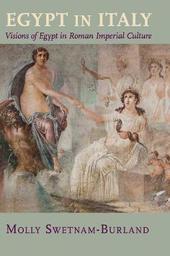
|
Egypt in Italy: Visions of Egypt in Roman Imperial Culture
Hardback
Main Details
| Title |
Egypt in Italy: Visions of Egypt in Roman Imperial Culture
|
| Authors and Contributors |
By (author) Molly Swetnam-Burland
|
| Physical Properties |
| Format:Hardback | | Pages:261 | | Dimensions(mm): Height 261,Width 185 |
|
| ISBN/Barcode |
9781107040489
|
| Classifications | Dewey:709.320937 |
|---|
| Audience | | Professional & Vocational | |
|---|
| Illustrations |
8 Plates, color; 62 Halftones, unspecified; 10 Line drawings, unspecified
|
|
Publishing Details |
| Publisher |
Cambridge University Press
|
| Imprint |
Cambridge University Press
|
| Publication Date |
6 April 2015 |
| Publication Country |
United Kingdom
|
Description
This book examines the appetite for Egyptian and Egyptian-looking artwork in Italy during the century following Rome's annexation of Aegyptus as a province. In the early imperial period, Roman interest in Egyptian culture was widespread, as evidenced by works ranging from the monumental obelisks, brought to the capital over the Mediterranean Sea by the emperors, to locally made emulations of Egyptian artifacts found in private homes and in temples to Egyptian gods. Although the foreign appearance of these artworks was central to their appeal, this book situates them within their social, political, and artistic contexts in Roman Italy. Swetnam-Burland focuses on what these works meant to their owners and their viewers in their new settings, by exploring evidence for the artists who produced them and by examining their relationship to the contemporary literature that informed Roman perceptions of Egyptian history, customs, and myths.
Author Biography
Molly Swetnam-Burland is associate professor in the Department of Classical Studies at The College of William and Mary. She has received fellowships from the Getty Research Institute, the Archaeological Institute of America, the Deutsches Archaologisches Institut in Berlin, and the University of Cincinnati. She has published articles in the American Journal of Archaeology, The Art Bulletin, and several edited volumes.
Reviews'The author is to be applauded for showing how important it is to think of Roman material culture as precisely that - Roman - serving the needs and concerns of its Roman patrons, despite its historical or stylistic origins. She succeeds in her aim of integrating Egyptian-style objects into the wider history of Roman art, and in showing that context matters, with objects' meanings changing along with their owners and viewers. It is an important contribution to our wider understanding of the extent to which Roman culture in general, and Roman art in particular, was forged in the crucible of appropriation.' Zahra Newby, The Journal of Roman Studies
|